“I fear that he who walks over these fields a century hence will not know the pleasure of knocking off wild apples. Ah, poor man, there are many pleasures which he will not know!”
– Henry David Thoreau
It is always in September when something in the fall of the light, or the movement of the air, first begins to betray the summer’s hesitation. The days are still warm, and the evenings mild, but even the best of them lack a certain component — call it a depth of character, or a strength of conviction — whose absence is the first evidence of a fleeing momentum. It is a subtle signal, easily missed, as with a resting on laurels, or the pride before a fall. May and June had days of similar perfection, but they were carried upon a quickening current of promise and ambition; September only poses and postures on a theme of August’s success. Just as a drink is gradually watered by the ice that chills it, now is when we begin to perceive the accumulated debt of pleasure and convenience, deferred but coming due.
The evening shadows have already entered retrograde, swinging back toward another equinox. Leaves are not as dense, nor grass as thick; the green has peaked and fallen back, and returns a measure of transparency to those few margins of the wild with which we still engage. Then comes a day when the winds pick up a bit more persistently than the idle business of a summer breeze could possibly explain. Evening falls harder and more suddenly. How can twilight reach this deep a blue, this early, and this soon? Memories of another season begin to stir. They compete remarkably well, and gradually turn our thoughts toward the pastimes that honor them best.
Just as springtime brought the roadside foragers out to “stalk the wild asparagus,” fall-time conjures visions of wild apples — the tart and teasing sugar-plums of this evocative, transitional season.
When I first read Thoreau’s essay, Wild Apples, I discovered that I had frequently foraged in a similar spirit. Pressed on by unrequitable thoughts of brewing a batch of wild-apple cider (I have never had a cider press), I have nonetheless used the excuse to cruise many a country road, scanning for signs of the bright-red fruit among the thinning leaves, or better, a semicircle of drops, littering the gravel shoulder below.
My general record of disappointment might have been explained by the fact that I was already a poor man, by Thoreau’s account. It is not just a century hence, but nearly two, and the public domain that he would have roamed upon so freely has largely shrunken back to the narrow edges of the country roads. Protected from the ambitions of adjacent landholders by the ambiguity of their precise borders, these strips of unmarked right-of-way are some of the last places where we still abide the unscripted habits of uncultivated flora — and where an observant walker can be rewarded with a diversity of casual discoveries.
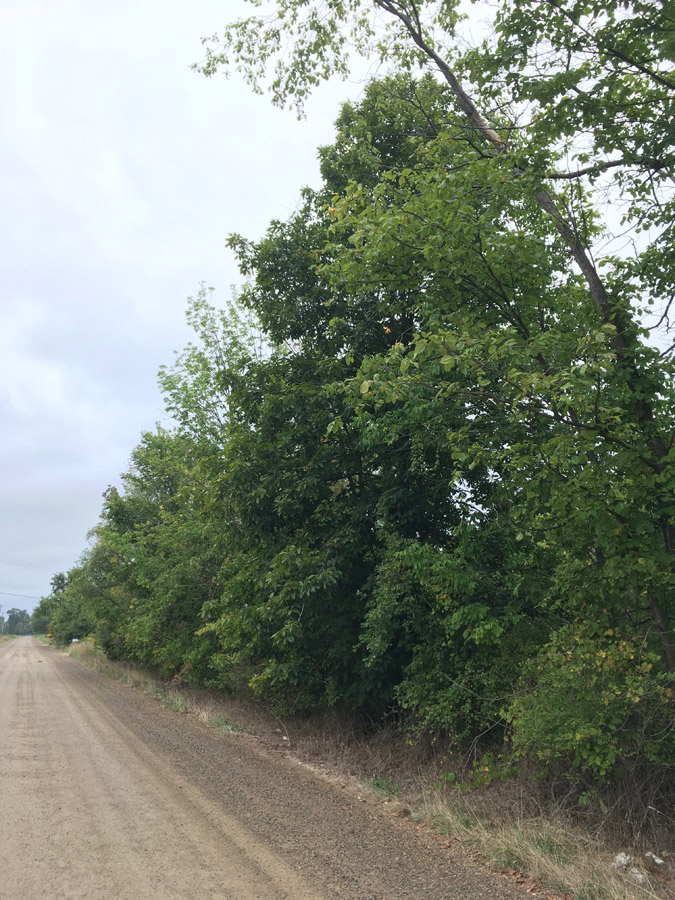
Somewhere within this leafy roadside grows a small apple tree, doubtless descended from the orchard that once filled the grassy field behind it. Dwarfed by much taller trees, it cannot be spotted from a car, but offers its bashful fruits only to a select few who happen by on foot. I have kept this little tree a secret, sharing its exact location with only one or two others, who I knew would share a similar appreciation. Its apples are sweet and crisp, although the yield is highly variable — in a good year, these seven were the crop, barely enough to make a pie. But as they were too good for that, they were eaten fresh, instead.
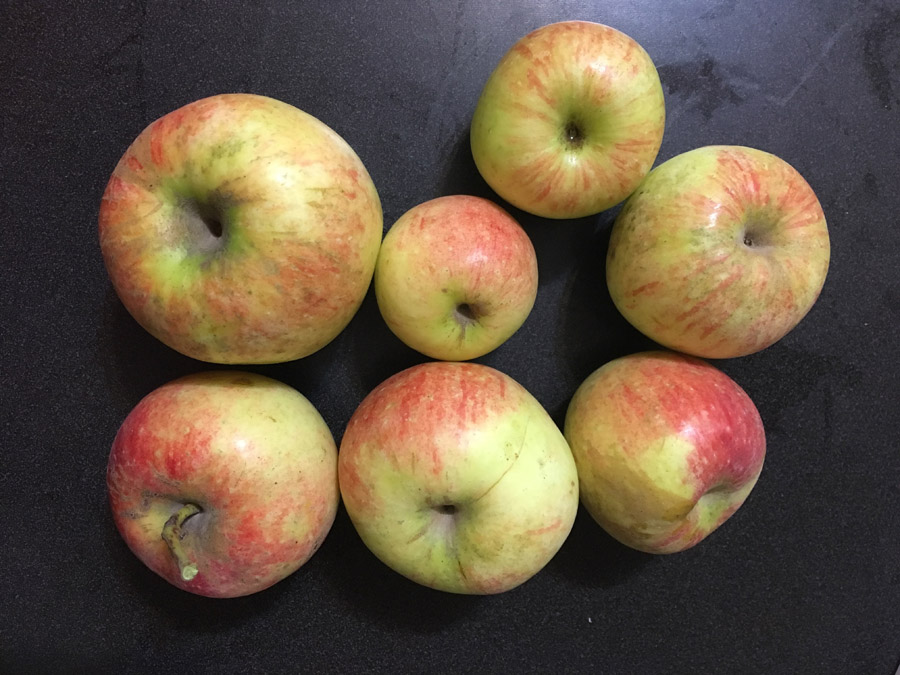
Echoes of orchards
Apples do not grow true to seed, which means that the seed of even the best apple will not produce a tree that simply bears more of the same — instead, the bee that pollinated its parent-apple’s blossom will have something to say about the matter. Among the diversity of variations that result, only a few are judged worthy enough to propagate. Every named variety of apple is grown on a tree that in turn grew from a grafted scion of a single, original parent tree, or of one of its graftees. Even the McIntosh apple was first discovered as a wild tree, and although the original tree died more than a century ago, it quite literally lives on — in the form of countless grafts that have propagated its tissue across time and place.
Genetic studies have shown that modern apples came to us via the Silk Road — not as a traded commodity, but by sprouting along the road itself, from cores discarded by snacking travelers from the East, where the ancestral apple grew. These early roadside trees cross-pollinated with local European varieties, and from this international exchange experience, the apple gradually gained the amiable traits that we know today.
Few motorists snack on apples, and even fewer toss their cores to the curb. Thus our roadside trees now seem to be dominated by random variations on the crabapple, the tiny variety that is more often traded among birds and squirrels. Still, a persistent roadside shoulder-surfer can find a few trees that bear larger fruits — the kind that have to be “knocked off” when they grow too high to reach. Where these larger apples are found growing wild, it is often evidence of a nearby orchard that is now gone — but in that way, it is remembered.
Ragged remnants
Having grown up on a property with a fallowed apple orchard, it was with great interest that I discovered a hidden grove of apple trees on the neighboring farm that I now own. In mid-20th century lower Michigan, it was a common thing for a person with a day job to plant an apple orchard as a side hustle. This farm once had a mature and well-maintained orchard of several acres that fronted the property, and as a child I remember sometimes seeing the owners loading their small pickup truck with cratefuls of apples, headed for Eastern Market, in Detroit.
That orchard is long gone, but on purchasing the property I discovered a smaller family orchard in the rear. In fact, these trees have been so feral for so long that they have spawned numerous smaller trees nearby that have full claim to the title of wild. A particularly sweet, small, ruby-red apple, seen twice in the photo below, was growing from a young sapling living next to the base of a large mulberry, where no person would have intentionally planted a commercial tree. Its wild credentials are clear, and could as easily be lent to the disheveled, but delicious, orchard fruits that accompanied it.

Indeed, these weakened trees, shaded by overgrowth, had borne so few apples for so many years that, coupled with the absence of other orchards nearby, they might have broken the life cycle of the local codling-moths that would have spoiled their fruit. For that first year, after I cleared the overgrowth to bring in some sunlight, these trees produced large amounts of almost perfect fruit, as innocently as those first few English trees that were brought to the New World. While scab and other viral afflictions were abundant, among the hundreds of apples I could see, only a very few were inhabited by worms.


But it was a brief innocence. Freed from the shrubby undergrowth that I had removed, they became newly vulnerable to the hordes of deer that live nearby. It took only one winter for every bud to be nibbled from their exposed branches, and the trees effectively killed. It occurred to me that deer were largely extirpated from this part of Michigan when small orchards like these were common, and that any attempt to recreate the typical small orchard of the time would have to take that fact into account.
A growth habit is hard to break
I’ve since found some solace in spotting orchard remnants amid the sprawling suburban landscape. Trees that have been pruned for fruit production develop a distinct character by which we can often tell them from the wild. Even when the orchardist has turned to new tasks, and the tree has sidled in to a thicket, we can see in its cantilevered limbs and low crotch the mark of domestication, and thus the potential for a quality fruit. Occasionally, former orchard trees persist in the edges and outlots of properties that have otherwise been developed. I stopped one day to photograph these wayside remnants, which stood out clearly from the edge of a construction site. They keep the same iconic profile that once moved Van Gogh to paint an uncannily similar scene, though separated by a century and a continent.
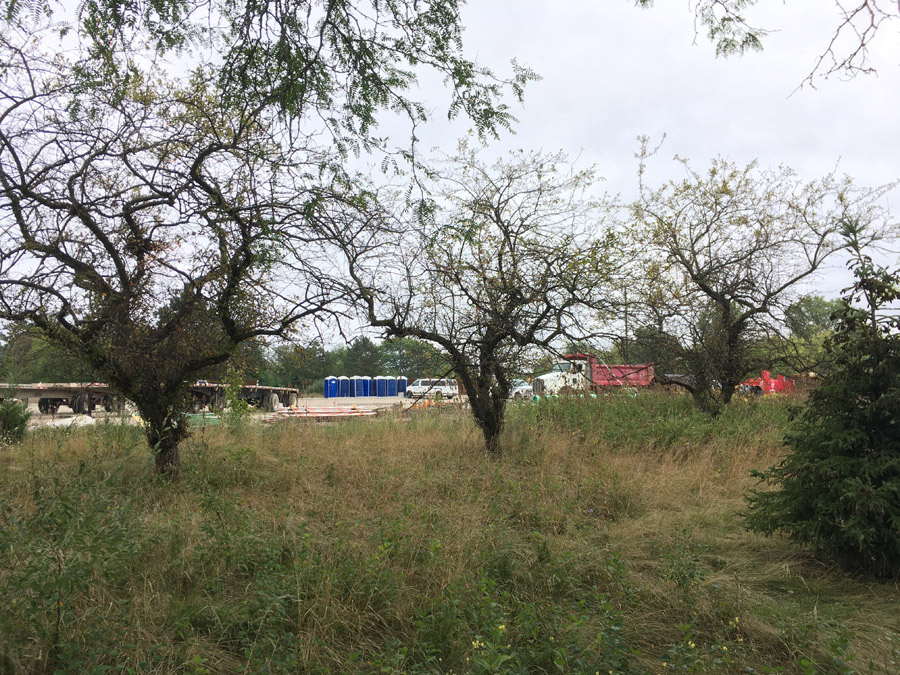
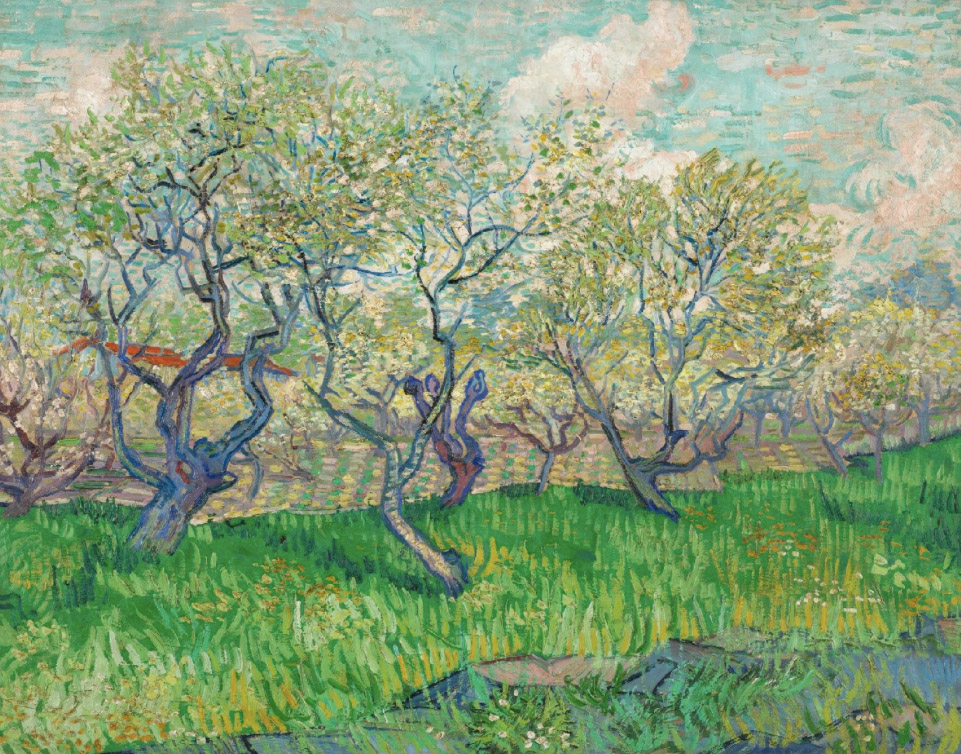
Borrowed time
I feel blessed that even after decades of absence, I returned to find that many of the country roads that I knew as a child remain much the same as they were. There is something about the terrain and terroir of lower Michigan that permits these roomy dirt roads to continue to exist, moderating traffic speeds and preserving walkability, even as similar roads in other states are customarily paved.
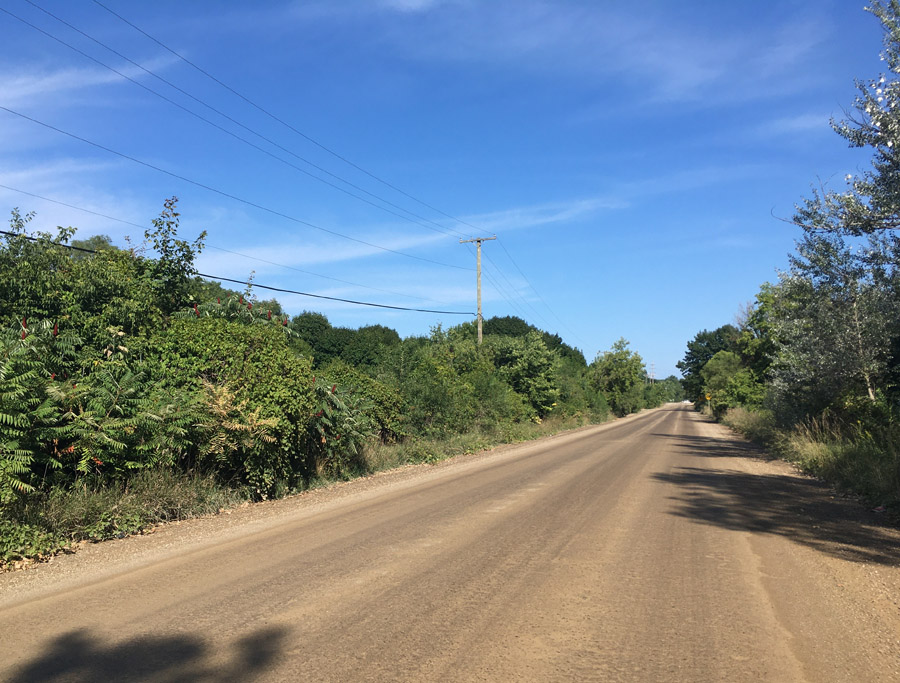
Yet many here have also been lost to pavement, and where this has happened, they default to narrow, high-speed death traps, unsafe for any hiker. Long stretches of those that can still be sauntered upon have lost their scrubby right-of-way to the compulsively manicured edges of people’s yards, which broadcast nothing to passersby but their success at imitating suburbia, in a place where it arguably does not belong.
In other places, gargantuan suburban developments have affected the municipal authorities with such enthusiasm that the roads have overspilled their reasonable boundaries, widened with needless turn-lanes and edged by even wider banks of turf, that broadcast nothing of interest but their ability to attain the perfect shade of money-green. What substitute, lawn and languor, for the candid exuberance of a simple country lane?
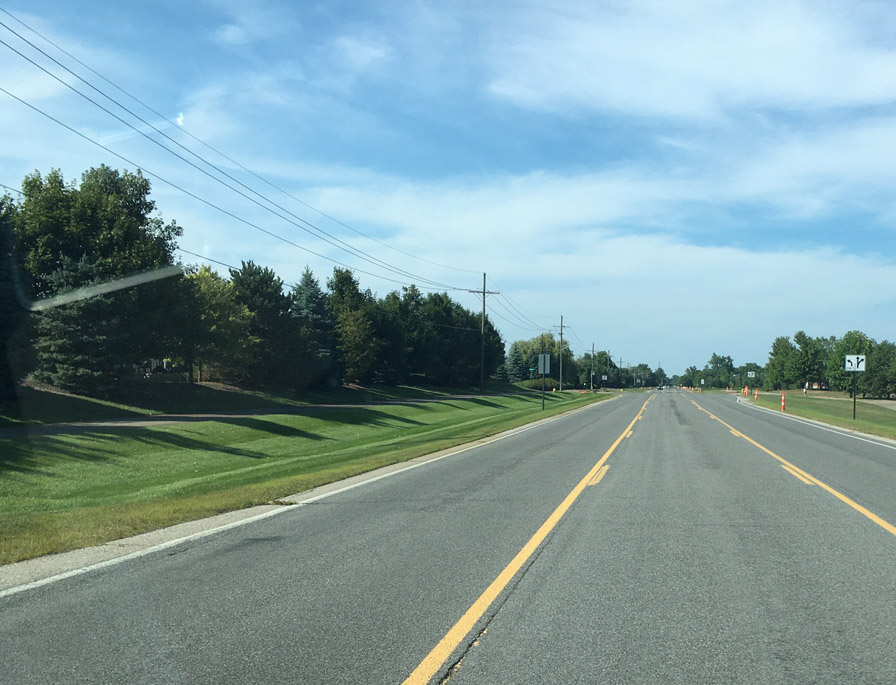
Once upon a time, when this very stretch of pavement was still a humble stretch of dirt, a roadside apple tree halted my car with a scattering of golden fruit, fallen from a leafy canopy above that embraced the road like a tunnel. I gathered a bagful, and peeked through the roadside shrubs to admire the open fields beyond, wondering what other forage might be found among its fencerows.
The apples were good enough to remember, and I considered returning again, another year. But it is as I have shown.
Harvest time
Which brings us back to my secret apple tree, quietly hanging on, in an undisclosed location. What was the yield this year?
Approximately two. One was picked by a friend. The other we let remain, as I hoped to find it later, a bit riper than on the day of her visit.
… Ah yes, there you are! Still a bit shy, peeking from behind a leaf, and beginning to blush a bit on your sunny side — but still a little green on the other. Today I shall take your portrait, and then give you a slight twist of the stem, to warm your other side. I’ll be back in a couple of days. Until then, my sweet.
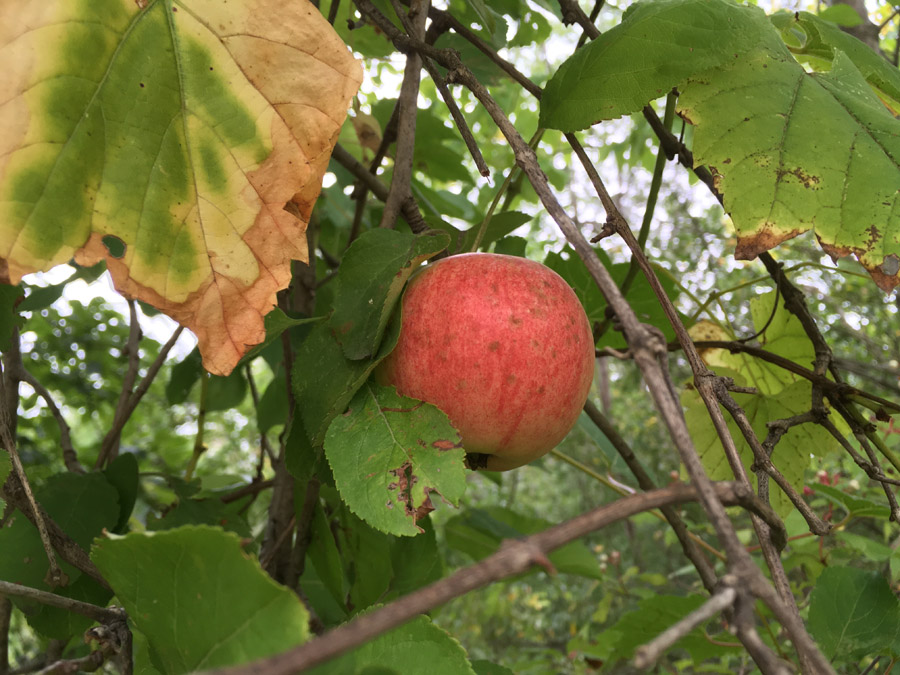
But, as way led on to way, those two days stretched to a week. When I checked again, there was not a trace — not of apple, twisted stem, fallen drop, nor core. It had left me for another.
Perhaps I was not the only passerby who knew of this unlikely treat, growing inexplicably on their daily walking path — and who, so distraught when their count of two had suddenly declined to one, chose not to vainly admire — but to act.
Article and photos Copyright 2022 by the author.

